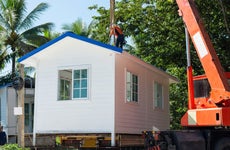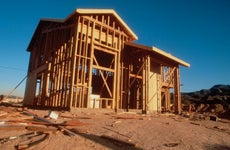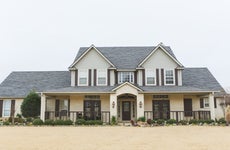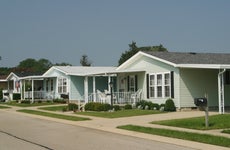What is a manufactured home?
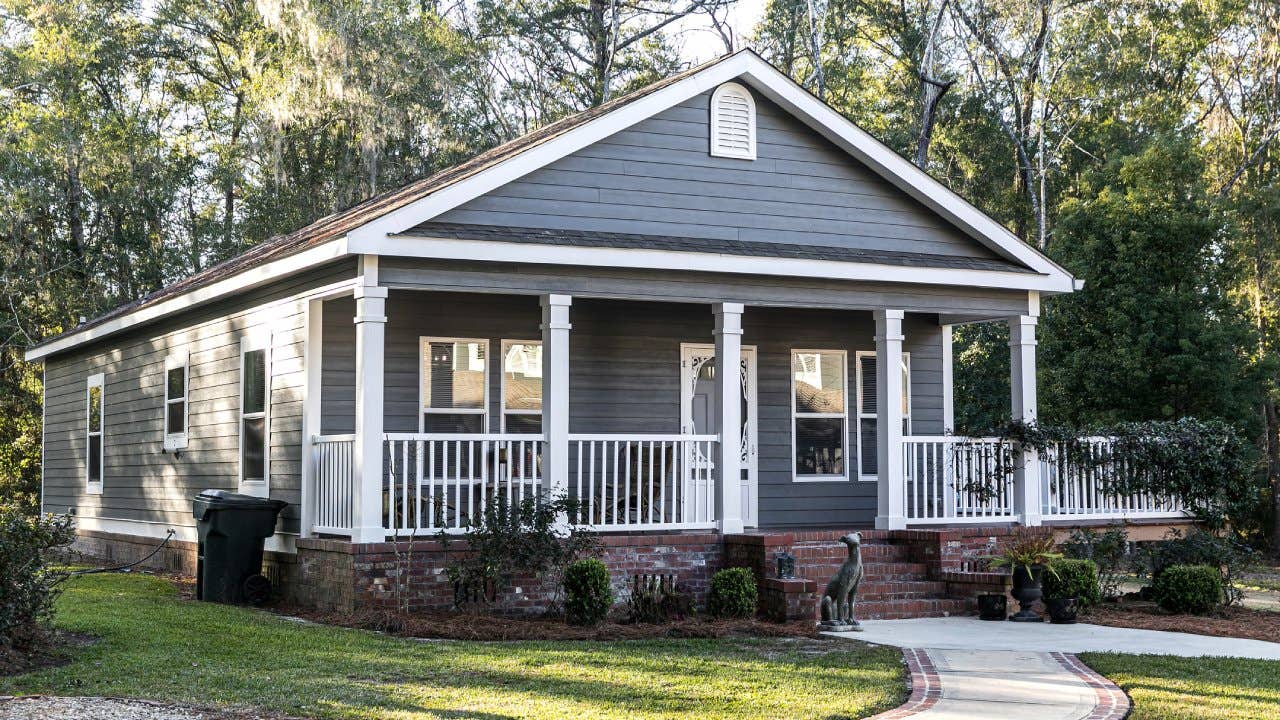
The Bankrate promise
At Bankrate we strive to help you make smarter financial decisions. While we adhere to strict , this post may contain references to products from our partners. Here's an explanation for .
The price tags for homes are high these days. But if you want to build the home of your dreams, the costs can add up quickly too: The average price of a new-construction house in January 2022 was nearly $500,000, according to the U.S. Census Bureau. Ouch.
But there’s a cheaper alternative: the manufactured home. These prefab, permanent residences are factory-built, then installed on a lot. The average sale price of a manufactured home, as of February 2022, was $128,000, according to the U.S. Census Bureau (exclusive of land cost or other expenses). Even the biggest, most deluxe models can be around $250,000.
Though traditionally associated with temporary housing and trailer homes, these days manufactured homes can be just as permanent as on-site builds. Nor do you have to sacrifice space or functionality when you live in a manufactured property. In fact, the average size home purchased is approximately 1,400 square feet, and some floor plans can exceed 3,000 square feet.
Some 22 million Americans live in manufactured homes, according to the Manufactured Housing Institute’s “2021 Industry Overview.” Should you join them? Let’s talk more about why you might want to consider manufactured housing the next time you buy or build.
What is a manufactured home?
A type of prefabricated residence, the manufactured home, as its name implies, has its standardized parts constructed and assembled in a factory; it’s then transported and affixed to a location (your home site). In contrast, a traditional home is built from the ground up on your lot. While traditional homes may have a basement and usually sit on a foundation, manufactured homes typically don’t.
But that doesn’t mean your manufactured home is on wheels or meant to be a mobile residence. They can be set up at their permanent location on concrete blocks, metal piers or other substantial tie-downs. As Terrianne and Jinx Kidd, manufactured homeowners in Outer Banks, North Carolina, explain: “Our home is built on 75 concrete footings instead of a foundation, and it’s designed to withstand hurricane winds up to 160 mph.” Their house has 9-foot ceilings and 2X6 sheetrock studs, and Terianne is happy that the manufactured home builder gave them a ton of customization options and “built it indoors to our specifications.”
Indeed, a manufactured home can have many of the hallmarks of a traditional home build. This includes lumber framing, fiberglass insulation, PVC plumbing, drywalls and wood flooring. They can boast fancy trims and features like porches or exterior stairs. Homeowners can choose between multiple floor plans and select everything from countertops to tile based on their preferences.
Manufactured homes vs mobile homes
Manufactured homes are often referred to as mobile homes — and indeed, the two are in a sense the same thing. Both types of properties are regulated by the Department of Housing and Urban Development (HUD). The main difference between a manufactured home and a mobile home is the date it was built. Homes built in a factory before June 15, 1976 are considered mobile homes, while factory-constructed homes built after that date are called manufactured homes.
Manufactured homes are still “mobile” in that they have a trailer hitch and axles attached to a steel beam that runs their length (which allows them to be transported to the home site). They are considered a vehicle for tax and zoning purposes, because, technically, they can be relocated.
Other than that, they often bear little resemblance to the rectangular, metallic, trailers-with-the-wheels-off of old. As noted above, manufactured homes are solidly built, can be affixed to the land in fairly permanent ways, and often run as much as 2,000 or 3,000 square feet (what the industry calls double- or triple-wide).
Mobile homes, being older, are often less expensive to buy than contemporary manufactured homes.
Manufactured homes vs modular homes
Manufactured homes are also often confused with modular homes. Both are forms of prefab housing — built in a factory in sections and shipped to the land where they will be set up. Both have standard features that can be customized to varying degrees.
However, they differ in significant ways, starting with the way their construction is regulated. Manufactured homes are subject to HUD standards, which regulate their design, energy efficiency, and safety, while modular homes are subject to local, state and regional building codes.
Manufactured homes are built on a steel chassis, like a car, and transported to their site. In contrast, modular homes are more like traditional builds. Constructed in pieces and assembled like a puzzle on the property, they generally have permanent foundations and a roof that’s pitched per local regulations. A modular home might even have a basement or crawl space.
Because they are often subjected to more serious code specifications, a modular home may be more expensive than a comparable manufactured one. Manufactured homes cost around $40 to $50 per square foot compared to $40 to $80 per square foot for modular homes, according to HomeAdvisor. According to Fixr, the average cost on a 2,000-square-foot modular home runs about $240,000. A comparable manufactured home runs more towards $150,000-$170,000.
How much do manufactured homes cost?
Overall, manufactured homes are less expensive than traditional homes. According to HomeAdvisor, their total cost is around $100-200 per square foot; in contrast, a traditional new-build home averages $150 per square foot, and can easily go as high as $400, depending on the locality.
When you’re figuring out the cost of your manufactured home, consider the following:
- Are you buying the land the home will sit on? This additional cost can be in the tens of thousands of dollars. Some homeowners rent a space in a manufactured home park instead.
- Do you want lots of upgrades and luxe features? Switching from carpeted to hardwood flooring or from laminate counters to granite counters will cost more, just like in a traditional home.
- Are you making it permanent? If you want to put your factory-built home on a foundation, it will become like a modular home, and thus liable to standard building codes. This process can be more costly.
Financing a manufactured home
It’s more difficult to get financing for a mobile or manufactured home than a traditional on-site build. Both online and traditional lending institutions will offer standard financing on modular homes because they meet the same local code requirements as traditional builds, but they often won’t finance manufactured homes.
The situation eases a bit if you own the land, and build the manufactured home to stay in place via a foundation (like a modular home) or some other permanent way. Mainstream mortgages would be available to you in this scenario.
If you are buying an older mobile home or a non-modular manufactured home, you will probably have to turn to a private personal loan to get financing. Many homebuyers take out a chattel loan — manufactured homes are often classified as personal property, or chattel — especially if they buy an existing manufactured home away from the lot where they intend to keep it. Chattel loans carry higher interest rates than traditional mortgages do.
A variety of HUD loans, including Federal Housing Administration (FHA) loans and Veterans Affairs (VA) loans are available for financing manufactured homes in many circumstances.
Pros and cons of manufactured homes
Manufactured homes are gaining momentum, thanks in large part to their affordability and increasingly customized floor plans. Still, they may not be right for every home buyer.
The advantages
- Affordability: Manufactured homes cost at least half the price of comparable traditional new homes.
- Speed: Manufactured homes take less time to construct.
- Easy to maintain: The standardized parts can often be quickly replaced. The home is under a manufacturer-offered warranty.
The drawbacks
- Less equity: Manufactured homes are more likely to depreciate over time than a traditional build. They may not be great for buyers who want to move in a few years.
- Financing: You will find fewer loan options for most manufactured homes.
- Cookie cutter: While design options do exist, manufactured homes are harder to personalize — or update later on. And while model homes may be available for viewing, you won’t see your actual home until it arrives.
- Limited: Manufactured homes aren’t available everywhere. Some localities restrict where they can be located, too.
Final word on manufactured homes
A manufactured home can be a great forever home if you want more for your money. You can customize the property and enjoy more space than you could otherwise afford. Many retirees and empty-nesters find them ideal.
Manufactured homes do still suffer from the old temporary, trailer-home stigma though. They don’t appreciate as well as traditional homes do — so forget about them being good for a quick flip. Be aware that your financing options to buy or build one may be limited, too.
Related Articles
